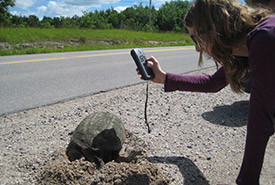All together for turtle protection!

Snapping turtle, data collection (Photo by NCC)
It’s not unusual to see turtles leave the relative safety of wetlands to travel on land. During their active season, from May to October, turtles are on the move, searching for food, finding new habitat, looking for a mate or laying eggs. Unfortunately, travelling on land and crossing roads carry their share of risks for turtles, as it makes them vulnerable to collisions or disturbance.
 The Nature Conservancy of Canada (NCC) is therefore proud to announce the launch of the Carapace Project’s website, which explains exactly what you should do if you spot a turtle.
The Nature Conservancy of Canada (NCC) is therefore proud to announce the launch of the Carapace Project’s website, which explains exactly what you should do if you spot a turtle.
While presenting the various species you might encounter, along with some practical advice, the site teaches you about the importance of protecting turtles. Indeed, turtles may take up to 25 years before reproducing, and only two eggs out of every 100 become adult turtles. The presence of humans in their habitat brings many threats and increases adult turtle mortality rates, which can have serious consequences on their overall population.
NCC and Carapace Project encourage you to report each sighting of a turtle, dead or alive, found in Quebec. In this way, important habitats for these species’ survival can be targeted to better focus protection efforts.
Click here to donate for the protection of turtles >>







